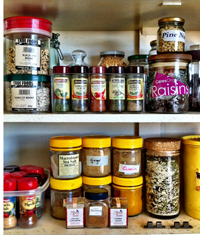by Kara-Leah Grant
Over two years ago I made a commitment to live out each yama in my life and write about the experience.
That series Applying the Yamas to Daily Life has been cornerstone content for The Yoga Lunchbox and has also been published in Asana Journal.
Now, at the prompting of my editor at Asana, I’ve embarked on the same mission for the Niyamas.
Every few weeks, I’m picking one niyama and studying it plus observing how it shows up in my life.
For those new to yoga, the yamas and niyamas spring from Patanjali’s Yoga Sutras, where he codifies the practice of Yoga into eight limbs, like branches on a tree. The yamas and niyamas outline how a yogi behaves toward him or herself, and others.
Not so much moral imperatives, the yamas and niyamas are ways of being that naturally arise as we practice the other limbs like asana, pranayama and meditation.
We can choose to impose them on ourselves and our lifes, but until we’re ready to naturally unfold in that direction, there will be some conflict or resistance. This in itself can be useful because it highlights areas of Self for us to look at and learn about.
The first yama is Saucha, usually translated as purity and sometimes as cleanliness.
No matter what kind of yoga we’re doing – asana, pranayama, meditation, chanting, Bhakti yoga, Karma Yoga, Jnana Yoga – we’re always working with purification. Yoga as a practice purifies our system and by extension, our lives.
This clearing out, on all levels, allows Prana (life force) or energy to flow freely. We release and dissolve all kinds of blockages.
This is what saucha is about – clearing out the dirt and removing the unnecessary. On a basic physical level it applies to how we clean ourselves. It’s the way we shower, scrape our tongues, clean our teeth, wear clean clothes and eat life-supporting, nourishing foods that move cleanly through our systems. Done daily, and with reverence, these simple practices will lay a strong foundation to our lives. We’ll feel better about ourselves.
On a deeper level, saucha shows up in our lives in other ways.
Saucha is about purity of energy, so in our homes, it’s about the way we organise and maintain our space.
Compare the feeling of walking into a zen-style room. The floor is wooden, there is a rug on the floor, aligned perfectly with the walls. Two pot plants fill separate corners. There is a sense of everything in it’s place and a place for everything. The room is light and airy.
Now walk into a cluttered lounge with furniture at haphazard angles, dirty dishes strewn around the room, weeks of newspapers stashed on the coffee table, clothes hanging over chair arms and toys strewn across the room.
How does it feel walking into each room? What is your inclination walking into each room?
In the zen-style room, my inclination is to sit and breathe. The energy of the room is pure.
In the cluttered lounge, my inclination is to clean up and find a place for everything. Then I can sit and breathe because now the energy of the room is pure.
That is saucha in action – the recognition that everything has it’s place and there is a place for everything. From that place of places, energy can flow smoothly. There is nothing to do but breathe.
There is good reason for this niyama and I notice it in my own life. Whenever I move into a house, first I have to get everything in order. It’s not a pristine manic order, but a sense of discovering where everything belongs so it can fulfill it’s function with maximum efficiency and beauty.
Living with a child means there’s often toys littering the lounge floor. But those toys have a place and when it’s time for bed, Samuel helps me put all his toys in their place. Underneath the daily messiness is a sense of order which we always return to, maybe not every single night, but most nights.
This adds a clarity to my life that makes my mind work better. I write better in a clean space. Everything flows smoother. The light of my life can shine brighter in a clean, orderly house when I’m clean and pure!
Imagine this – each of us has a light inside that shines out to the world. If the glass that surrounds that light is smudged, or blackened, our light will be dull or faded. The practice of saucha cleans the glass so the light can shine brightly.
My light-shining often takes the form of housework.
I’ve noticed that when I feel scattered or heavy I naturally do housework. I’ll start organising.
Maybe I’ll go to put something away in the fridge and notice the fridge door has smeared ketchup on it. I’ll fetch a cloth and clean that ketchup. In doing so, I’ll notice crumbs in the door shelves so take out the bottles and clean the shelves.
Half an hour later I will have completely cleaned out the fridge and arranged everything according to how we use it and how it best fits. The cleaning and ordering of my physical environment has a comparable effect on my psyche. I feel clean and ordered and clear again.
This is a completely different experience from cleaning a fridge because it ‘has to be done’. There’s almost a merging between myself and the fridge as I attend to it’s needs in the moment 😉
I known this about myself for five or so years now – that housework is meditative and therapeutic. It’s only through my study of saucha that I’m now able to put a name to my action. Making this conscious means I can choose to take action when required now – I can notice when I’m feeling out of sorts or scattered, take a look at my surroundings, and figure out what needs sorting out and cleaning. It’s brilliant!
How might saucha show up in your life?
How do you keep your body clean and pure? Your clothing? Your room? Your house? Your life?
Further Reading on Saucha (Purity or Cleanliness):
Yoga Journal, Teaching the Niyamas in Asana Class
There are several ways to incorporate the teachings of saucha. The first is to teach students put away their mats, props, and blankets in an orderly manner, with all the edges aligned, so that no one else will have to arrange them. This practice will help students cultivate an awareness of their surroundings.
Tell your students to be mindful of other students’ mats and to refrain from stepping on them as they cross the room to get props or go to the wall. Not only is this a hygienic practice, it also teaches the importance of keeping the energy of their own practice distinct from the energy of others. …Such a separation of energies is, once again, saucha.
Yoga Chicago, Saucha: Lucid Cleanliness by Swami Shraddhananda
In addition to the obvious advantages, there are a number of side benefits to eating unadulterated food, breathing clean air, having the ability to clean ourselves within and without and residing in clean homes and neighborhoods. Cleanliness and order lift our self-esteem, re info rce our knowledge that we are worthy of good experiences, and improve our personalities so we can experience balanced self-awareness. When we feel pure and clean, we can be clear about our intentions, unencumbered by gross and subtle imbalances.
Judith Lasater, Living the Niyamas
Another niyama is saucha, or purity. When I first began studying the Yoga Sutras I balked at this particular niyama because it sounded so judgmental. Of course I knew that it had to do with the obvious choice of such things as pure food and pure speech. But somehow to me the concept of “purity” smacked of a rigid view of life which saw the world as a profane place.
Yoga with Katrina, Niyamas: Saucha as Clarity and Purity
Saucha is a good place to begin when looking at your own personal practice, because it speaks to the importance of being organized and the far reaching benefits of cultivating purity internally and externally.
A couple simple examples: If your desk is a mess, how effective are you compared to when it is organized? If you’ve been eating ice cream and pizza, how do you feel compared to when you eat clean and healthy?
How do you feel when your house is clean and orderly versus when it looks like a clothing bomb exploded?


I continue to explore your website, catching up on many articles from the past which I missed… I did my 40 day Shodarshan Chakra Kriya which has been easy to continue on with . Still do my daily mantra work and the 40 days in a row has also helped me with a more regular pranayama practice.. every day instead of few times a week…. all with positive results… Thankyou for your site. Happy mothering. Teri’